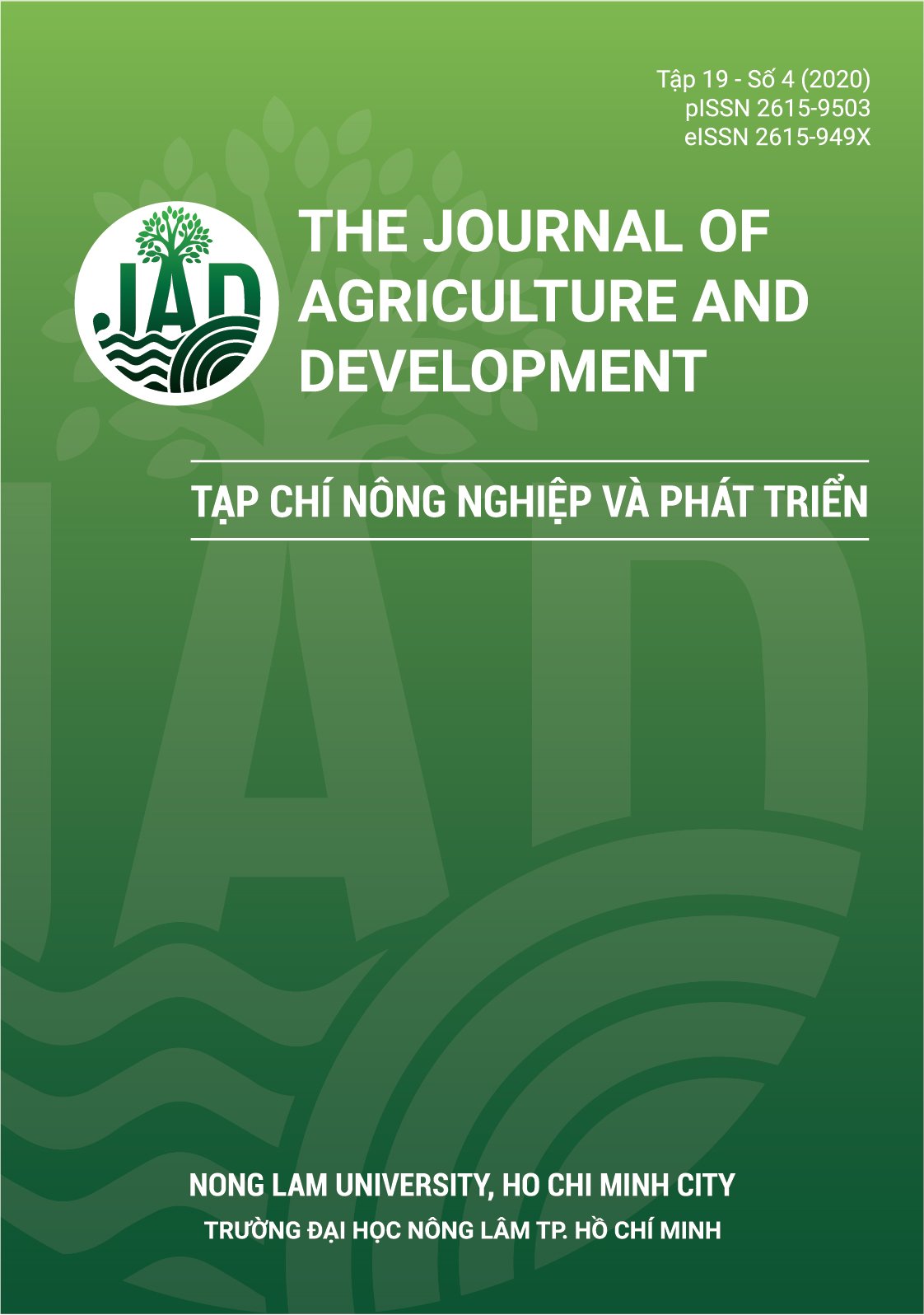Isolation and identification of lactic acid bacteria from vegetable-growing soils in Da Lat, Lam Dong
Main Article Content
Abstract
Lactic acid bacteria (LAB) have been used for decades in agri-culture to improve soils, control disease and promote plant growth. LAB have been isolated from fermented food, milks and plants, however, a few studies of LAB from soils have been reported. This study aimed to isolate, screen and identify LAB from vegetable-growing soils collected from Da Lat (Lam Dong province). From 33 soil samples, 25 LAB isolates were selected on MRS agar supplemented with 1% CaCO3. The LAB isolates formed small, creamy white, convex, entire margin colonies, and were Gram-positive, catalase-negative and rod-shaped bacteria. Based on the acid-producing capacity, five LAB isolates (DT2, CT3, CC2, XL7 and S2) that produced clear zones around colonies due to the solubilization of CaCO3 with diameters ranged from 1.03 – 1.33 cm, and 11.8 – 14.3 mg/mL acid after 2-day incubation at 30oC. All selected LAB isolates showed the capacity to inhibit the growth of Fusarium oxysporum at level 1 (inhibitory rates in range of 10.66 – 19.96%), and Phytopthora sp. at level 3 (inhibitory rates in range of 50.86 – 57.44%) af-ter 3 days. The isolates did not inhibit against E. coli and Staphylococcus but inhibit the growth of Bacillus spizizenii and Salmonella typhi with average inhibition diameters in range of 3.33 – 4.90 mm and 2.43 – 3.37 mm, respectively, after 1-day incubation. The five LAB isolates were molecularly determined to be Lactobacillus plantarum with 97 – 100% similarities.
Article Details
References
Abdel-Rahman, M. A., Tashiro, Y., & Sonomoto, K. (2013). Recent advances in lactic acid production by microbial fermentation processes. Biotechnology Advances 31(6), 877-902. https://doi.org/10.1016/j.biotechadv.2013.04.002
Andreev, N., Ronteltap, M., Boincean, B., & Lens, P. N. L. (2018). Lactic acid fermentation of human excreta for agricultural application. Journal of Environmental Management 206, 890-900. https://doi.org/10.1016/j.jenvman.2017.11.072
Caplice, E., & Fitzgerald, G. F. (1999). Food fermenta- tions: role of microorganisms in food production and preservation. International Journal of Food Microbiology 50(1-2), 131-149. https://doi.org/10.1016/S0168-1605(99)00082-3
Chaurasia, B., Pandey, A., & Palni, L. M. S., Trivedi, P., Kumar, B., Colvin, N. (2005). Diddusible and volatile compounds produced by an antagonistic Bacillus subtilis strain couse structural deformations in pathogenic fungi in vitro. Microbiology Research 160(1), 75-81. https://doi.org/10.1016/j.micres.2004.09.013
Chen, Y. S., Yanagida, F., & Shinohara, T. (2005). Isolation and identification of lactic acid bacteria from soil using an enrichment procedure. Letters in Applied Microbiology 40(3), 195-200. https://doi.org/10.1111/j.1472-765X.2005.01653.x
Daranas, N., Roselló, G., Cabrefiga, J., Donati, I., Francés, J., Badosa, E., Spinelli, F., Montesinos, E.,& Bonaterra, A. (2019). Biological control of bacterial plant diseases with Lactobacillus plantarum strains selected for their broad-spectrum activity. Annals of Applied Biology 174(1), 92-105. https://doi.org/10.1111/aab.12476
Ekundayo, F. O. (2014). Isolation and identification of lactic acid bacteria from rhizosphere soils of three fruit trees, fish and ogi. International Journal of Current Microbiology and Applied Sciences 3(11), 991-998.
Juodeikiene, G., Bartkiene, E., Cernauskas, D., Cizeikiene, D., Zadeike, D., Lele, V., & Bartkevic, V. (2018). Antifungal activity of lactic acid bacteria and their application for Fusarium mycotoxin reduction in malting wheat grains. LWT 89, 307-314. https://doi.org/10.1016/j.lwt.2017.10.061
Lamont, J. R., Wilkins, O., Bywater-Ekegard, M., & Smith, D. L. (2017). From yogurt to yield: Potential applications of lactic acid bacteria in plant production. Soil Biology and Biochemistry 111, 1-9. https://doi.org/10.1016/j.soilbio.2017.03.015
Lane, D. J. (1991). 16S/23S rRNA sequencing. In Stacke-brandt, E., & Goodfellow, M. (Eds.). Nucleic acid techniques in bacterial systematics (115-175). New York, USA: John Wiley & Sons.
Korsten, L., De Jager, E. S., De Villiers, E. E., Kotzé, J. M., & Wehner, F. C. (1995). Evaluation of bacterial epiphytes isolated from avocado leaf and fruit surfaces for biocontrol of avocado postharvest diseases. Plant Disease 79, 1149-1156. https://doi.org/10.1094/PD-79-1149.
Lutz, M. P., Michel, V., Martinez, C., & Camps, C. (2012). Lactic acid bacteria as biocontrol agents of soil-borne pathogens. Biological Control of Fungal and Bacterial Plant Pathogens IOBC-WPRS Bulletin 78, 285-288.
Mundt, J. O. (1970). Lactic acid bacteria associated with raw plant food material. Journal of Milk and Food Technology 33(12), 550-553. https://doi.org/10.4315/0022-2747-33.12.550
Qian, Y., Long, X., Pan, Y., Li, G., & Zhao, X. (2018).Isolation and identification of lactic acid bacteria (Lactobacillus plantarum YS2) from yak yogurt and its pro- biotic properties. Biomedical Research 29(4), 815-820. https://doi.org/10.4066/biomedicalresearch.29-17-3418
Stiles, M. E. (1996). Biopreservation by lactic acid bacteria. Antonie van Leuwenhoek 70, 331-345. https://doi.org/10.1007/BF00395940
Suzuki, T., & Yamasato, K. (1994). Phylogeny of spore- forming LAB based on 16S rRNA gene sequences. FEMS Microbiol Letters 115(1), 13-17. https://doi.org/10.1111/j.1574-6968.1994.tb06607.x
Talashi, S., & Sharma N. (2019). Isolation of Lactobacillus plantarum from human breast milk with probiotic and medical attributes. Acta Scientific Microbiology 2(6), 163-171.
Wakil, S. M., & Ajayi, O. O. (2013). Production of lactic acid from starchy-based food substrates. Journal of Applied Biosciences 71, 5673-5681. https://doi.org/10.4314/jab.v71i1.98811
Wang, H., Yan, Y., Wang, J., Zhang, H., & Qi, W. (2012). Production and characterization of antifun- gal compounds produced by Lactobacillus plantarum IMAU10014. PLoS One 7(1) e29452. https://doi.org/10.1371/journal.pone.0029452
Whipps, J. M. (1987). Effect of media on growth and interactions between a range of soil-borne glasshouse pathogens and antagonistic fungi. New Phytologist 107(1), 127-142. https://doi.org/10.1111/j.1469-8137.1987.tb04887.x
Xiao, P., Huang, Y., Yang, W., Zhang, B., & Quan,X. (2015). Screening lactic acid bacteria with high yielding-acid capacity from pickled tea for their potential uses of inoculating to ferment tea products. Journal of Food Science and Technology 52(10), 6727-6734. https://doi.org/10.1007/s13197-015-1803-6
Yanagida, F., Chen, Y., & Shinohara, T. (2006). Searching for bacteriocin-producing lactic acid bacteria in soil. The Journal of General and Applied Microbiology 52(1), 21-28. https://doi.org/10.2323/jgam.52.21
Yanagida, F., Suzuki, K. I., Kozaki, M. & Komagata,K. (1997). Proposal of Sporolactobacillus nakayamae subsp. nakayamae sp. nov., subsp. nov., Sporolactobacillus nakayamae subsp. Racemicus subsp. nov., Sporolactobacillus terrae sp. nov., Sporolactobacillus kofuensis sp. nov., and Sporolactobacillus lactosus sp. nov. International Journal of Systematic Bacteriology 47(2), 499-504.
Zebboudj, N., Yezli, W., Hamini-Kadar, N., Kihal, M., & Henni, J. E. (2014). Antifungal activity of lactic acid bacteria against Fusarium oxysporum f. sp. albedinis isolated from diseased date palm in South Algeria. International Journal of Biosciences 5(9), 99-106.








